Links:
IranVisitor.com
Blogs:
Bazaar Dispatch
Iran News Blog
Iran Travel & Tourism
Tools:
Calendar Converter

|
By: Bijan M. Sadeghi |
|
Culture: |
The first sentence of prominent Iranologist Richard Nelson Frye's last book on Iran reads:
"Iran's glory has always been its culture."
Persian culture is one of the richest in the world and is rivaled by only a few other cultures on Earth in richness and variety. Many ceremonies of the ancient Persians are the basis of the familiar western celebrations. These were mostly adopted by the Greeks and Romans and have worked their way into today's western societies. The Persians today, more or less celebrate most of the same ancient cultural festivities. In this segment we introduce these Persian traditions and festivities and look at their history.
The winter solstice, December 21st or 22nd, is the longest night of the year. Near the winter solstice, the length of the day changes very slowly, as does the Sun's height in the sky - one of the reasons why the long winter nights seem to go on forever!
In Iran, the winter solstice has been celebrated for centuries and it is called Shab-e yalda, which refers to the birthday or rebirth of the sun.Yalda is a Syriac word and means birth (tavalod and meelaad are from the same origin). The ceremony is traced to the primal concept of Light and Good against Darkness and Evil in the ancient Iranian religion. This night with Evil at its zenith is considered unlucky. The last day of the Persian month of 'Azar' is the longest night of the year. From this day forward, Light triumphs as the days grow longer and give more light. This celebration comes in the Persian month of 'Day', which was also the name of the pre-Zoroastrian creator god (deity). Later he became known as the God of creation and Light, from which we have the English word day (the period of light in 24 hours).

In the evening of Shab-e Yalda bonfires are lit outside, while inside the home, family and friends gather in a night-long vigil. In the past, fruit and vegetables were only available in season and the host, usually the oldest in the family, would have carefully saved grapes, honeydew melons, watermelons, pears, oranges, tangerines, apples, and cucumbers. These were then enjoyed by everyone gathered in the house.
On this night, the oldest member of the family says prayers, thanking God for previous year's blessings, and prays for prosperity in the coming year. Then he cuts the melon, and the watermelon and gives everyone a share. The cutting symbolizes the removal of sickness and pain from the family. Snacks are passed around throughout the night: pomegranates with angelica powder (gol-par) and Ajil-e shab-e yalda, a combination of nuts and dried fruits, particularly pumpkin and watermelon seeds and raisins. This mixture of nuts literally means night-grazing; eating nuts is said to lead to prosperity in days to come. More substantial fare for the night's feast include eggplant stew with plain saffron-flavored rice, rice with chicken, thick yogurt, and halva (saffron and carrot brownies). The foods themselves symbolize the balance of the seasons: watermelons and yogurt are eaten as a remedy for the heat of the summer, since these fruits are considered cold, or sardi; and halva is eaten to overcome the cold temperatures of winter, since it is considered hot, or garmi. On into the night of festivities the family keeps the fires burning and the lights glowing to help the sun in its battle against darkness. They recite poetry and play music, tell jokes and stories, until the sun, triumphantly reappears in the morning.
With the conquest of Islam the religious significance of the ancient Persian festivals was lost. Today "Shab-e yalda" is merely a social occasion, when family and friends get together for fun and merriment. Different kinds of dried fruits, nuts, seeds and fresh winter fruits are consumed. The presence of dried and fresh fruits is reminiscence of the ancient feasts to celebrate and pray to the deities to ensure the protection of the winter crops.
One of the symbolic rituals of the New Year celebrations occurs on the eve of the last Wednesday of the year (Chahar Shanbeh Soori, literally meaning "the eve of Red Wednesday"). On this magical night, families gather piles of brush or wood and bonfires are lit in public places. They then leap over the flames shouting:
"Sorkhi-e to az man, zardi-e man az to!"
"Give me your vibrant red hue, and take back my sickly yellow pallor!"
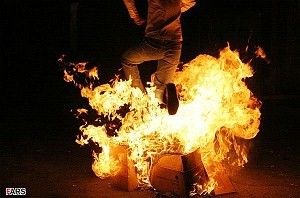

The essence of this tradition is giving thanks for the previous year's health and happiness, while exchanging any remaining paleness and evil with the warmth and vibrancy of the fire.
According to tradition, the living are visited by the spirit of their ancestors on the last days of the year, and many children wrap themselves in shrouds, symbolically re-enacting the visits. They also run through the streets banging on pots and pans with spoons and knocking on doors to ask for treats. The ritual is called qashogh-zany (spoon beating) and symbolizes the beating out of the last unlucky Wednesday of the year. This could be seen as the Iranian version of the Western Halloween night.

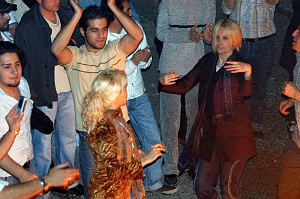
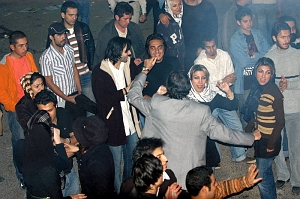
Today the occasion is accompanied by fire works from locally made firecrackers. There is no religious significance attached to it any more and is a purely secular festival for all Iranians. On the eve before the last Wednesday, bonfires are lit through out the streets and back alleys, or with the more prosperous, inside walled gardens. People leap over the flames while shouting; 'sorkhie to az man, zardieh man az to'.
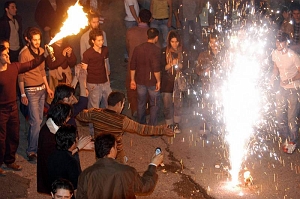

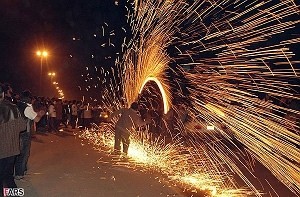
In parallel with the rebirth of nature, extensive spring-cleaning is a national tradition observed in almost every household in Iran. This is also extended to every persons attire, and it is customary to buy at least one set of new clothes.
.jpg)
.jpg)
.jpg)
The traditional herald of the Noe-Rooz season is called Haji Firooz. He symbolizes the rebirth of the Sumerian god of sacrifice, Domuzi, who was killed at the end of each year and reborn at the beginning of the New Year. Wearing black make up and a red costume, Haji Firooz sings and dances through the streets with tambourines and trumpets spreading good cheer and the news of the coming New Year.
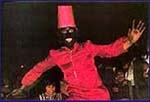
"Noe-Rooz" (Nowruz) celebrates the coming of spring by nations of Aryan heritage or Iranians.
In the Persian language "Noe"means "new", and "Rooz" means "day". Hence, "Noe-Rooz" means "new day".
Noe-Rooz occurs at the exact time of the Vernal(Spring) Equinox, when the length of night and day are equal. Translated literally, Equinox means "Equal Night". Because the sun is positioned above the equator, day and night are about equal in length all over the world during the equinoxes.
A true Earth year is 365 days, 5 hours, 48 minutes and 64 seconds, which is the time taken for the Earth to complete one orbit around the sun.
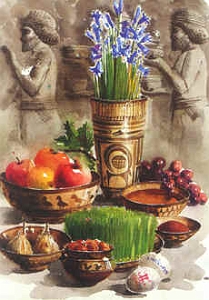
Every four year an extra day is added to the calendar (called a Leap Year), to adjust for this extra 1/4 of a rotation each year. This correction was introduced at the time of Julius Caesar (46 B.C.) and allows the calendar to always measure the location of the Earth in its orbit about the sun accurately. Thus, the Spring Equinox can fall on different days (either March 20th or 21st).
People around the world have recognized the vernal equinox for thousands of years. There is no shortage of rituals and traditions surrounding the coming of spring. Many early peoples celebrated at this time, for the basic reason that their food supplies would soon be restored. The date is significant in Christianity because Easter always falls on the first Sunday after the first full moon after the Vernal Equinox. It is probably no coincidence that early Egyptians built the Great Sphinx so that it points directly toward the rising of the Sun on the day of the Vernal Equinox.
The ancient Iranians celebrated two seasons. One was "Zayana" or winter, (the festival of Mehr'gaun) and the other "Hama", summer, celebrated by the festival of Noe-Rooz to announce its coming.
The origins of Noe-Rooz (Nowruz) are unknown, but they go back several thousand years predating the Achaemenian Dynasty.
The ancient Iranians believed that mankind is the masterpiece of physical creation and the representative of the Creator in the entire universe. Also, that it is the manifestation of the Heavenly spirit or soul in a terrestrial body, which gives man a temporary presence on earth. The spirit or soul which is a gift from God is called "Far'vahar", who enters the body of the embryo in the womb of the mother instilling life. Therefore each living person possesses a part of the Divine Power in him/herself. While a person lives, Far'vahar protects the body and sees that the person is associated with goodness and good deeds. When a person dies, Far'vahar returns to its origin. However, it will not forget or cut its ties with its terrestial shell. Once a year Far'vahar descends upon the dwellings of descendants on 15th March and stays until 24th March, to check that their lives are happy, clean and virtuous. A month before Noe-Rooz the descendants of the deceased clean their homes thoroughly and obtain new garments and shoes, so that the Far'vahar of their departed can see that they are happy and prosperous. An important reason why the first month of the new year is called Far'vardeen is for the descent of the Far'vahars.

The fight between the lion and the bull as depicted on the triangular sides of the great staircases of the Apadana, Persepolis. The lion is a symbol for the "sun" and "strength", and the bull is a symbol for the "earth" and "affluence". This image represents the return of the sun to the earth, at the time of Noe-Rooz.
The Zoroastrians of ancient Persia celebrated the creation of life by offering their god, Ahura Mazda, seven trays filled with symbolic objects representing truth, justice, good thoughts, good deeds, virtue, prosperity, generosity and immortality.
Today, the tradition is continued through the setting of the table or spread with an arrangement of several items of which seven of them start with the Persian letter Seen (in English S). The Persian translation for the number seven is "Haft", hence, "Haft Seen" means "Seven S's". It is customary for the family to gather round the Haft Seen spread a few hours before the New Year and recite poems from Hafez and verses from the Holy Quran. At the exact moment of the New Year, the oldest person in the family continues the traditions by hugging and wishing each member well and offering sweets, pastries, and coins. Banknotes are sometimes placed between the pages of the Holy Koran to bless them before they are given to the younger members of the family.
|
The contemporary Haft Seen spread includes seven of the following items:
|
"The Haft Seen Table" |
|
The other items in the spread include:
|
|
On the New Year's day, families dress in their new clothes and start the twelve-day celebrations by visiting the elders of their family, then the rest of their family and finally their friends. On the thirteenth day families leave their homes and picnic outdoors. The thirteenth day celebrations, Seezdah Bedar, stem from the belief of the ancient Persians that the twelve constellations in the Zodiac controlled the months of the year, and each ruled the earth for a thousand years. At the end of which, the sky and the earth collapsed in chaos. Hence, Noe-Rooz lasts twelve days and the thirteenth day represents the time of chaos when families put order aside and avoid the bad luck associated with the number thirteen by going outdoors and having picnics and parties.
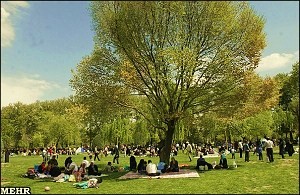


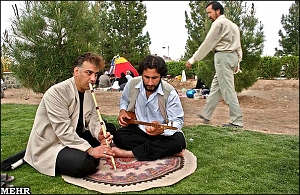



At the end of the celebrations on this day, the sabzeh grown for the Haft Seen spread (which has symbolically collected all the sickness and bad luck) is thrown away into running water to exorcise the demons (divs) and evil eyes from the house hold. It is also customary for young single women to tie the leaves of the sabzeh, prior to discarding it, symbolizing their wish to be married before the next year's Seezdah Bedar. When tying the leaves, they whisper...
The festival of Noe-Rooz represents a major part of the Iranian peoples' rich culture and is one of the cornerstones of their civilization. In spite of a stormy history of civil wars and foreign occupations, the Iranians have managed to preserve the spirit and traditions of Noe-Rooz throughout the centuries, and continue to do so today, no matter where they reside.
Your Comment: |
|
| Rate : | |
| Name : | *Required |
| Email : | *Confidential |
| Comment : | |
 |
|